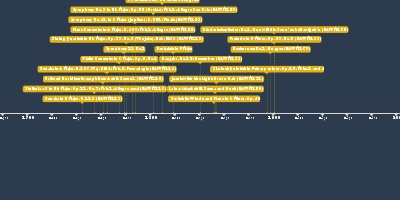jan 1, 1803 - Symphony No. 3 in Eb Major, Op. 55 (Eroica): Mvt. 1, Allegro Con Brio (NAWM 126)
Description:
Composer: Ludwig van BeethovenGenre: Symphony
Beethoven originally called this symphony “Bonaparte” in honor of Napoleon, who promised the French revolution's liberty, equality, and fraternity. By 1806 he fervently changed the title to just the heroic symphony, “composed to celebrate the memory of a great man”. Many scholars believe that this piece's heroism was Beethoven’s own courage in continuing to write music in spite of his growing deafness.
Reception
The first audiences had mixed feelings about this piece; some rated it a masterpiece while others found it too long, difficult, and strange.
All the movements indeed departed in unexpected ways from Beethoven’s previous symphonic writing. The first movement alone was as long as entire symphonies from the previous generation.
First Movement Heroism
The expansive form, thematic richness, and exciting climaxes all contribute to this movement's heroism.
Form
Overall, the movement employs typical sonata form. Within this, though, the principal motive is treated like a character in a drama, portrayed as striving, being opposed and subdued, and eventually triumphing.
Principle motive
Unusually, it first appears with cellos instead of violins. The motive is initially not like a fanfare, being played in a low register and soft dynamic level. Over the course of the movement, though, this principal motive undergoes radical transformations that suggests a growth from its initial pastoral character to heroic stature. It is challenged in the development by dissonance and rhythmic disruption, but at the end of the development the principle motive achieves its heroic form, leading to the recapitulation. This new form is confirmed in the recapitulation and triumphantly asserted in the horns at the coda.
Strange Things:
-The development (244 measures) exceeds both the exposition (153) and recapitulation (153), while the coda (141) is almost as long as exposition.
-There's a new theme in the middle of the development.
-Disconcerting and abrupt key changes: Eb-F-Db in the recapitulation, and Eb-Db-C in the coda
-Certain passages are insistently dissonant
-French horn seems to state theme prematurely before the recapitulation (as many early listeners noted)
Added to timeline:
Date:
jan 1, 1803
Now
~ 222 years ago
